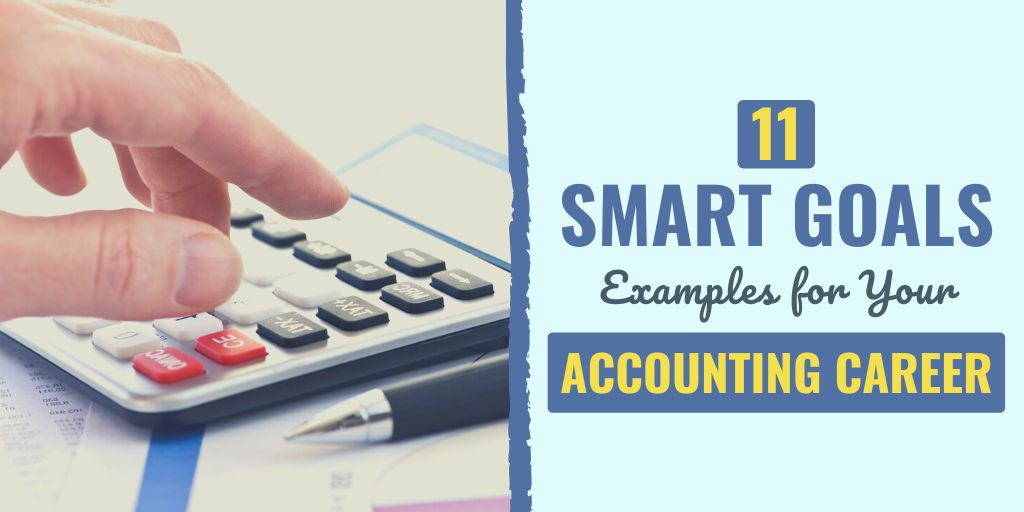There might be affiliate links on this page, which means we get a small commission of anything you buy. As an Amazon Associate we earn from qualifying purchases. Please do your own research before making any online purchase.
Goals can motivate you to stand out and become the best accountant you can be. Using a SMART goal framework, you’ll have measurable objectives that systematically help you increase your chances of achieving them.
For any goal for career enhancement, SMART goals can help get you there. Read on for eleven accounting smart goals examples you can use or for an idea of how to design them.
What Are SMART Goals?
SMART goals are a goal-setting guide used to plan specific objectives towards achieving a goal. The term is an acronym that stands for Specific, Measurable, Achievable, Relevant, and Time-bound. Goal setting under the SMART framework ensures success in meeting your goals with a solid plan for how and what’s considered an achievement.
Each component is broken down as follows:
Specific
Your goal will have a significantly higher chance of being accomplished when specific. So here we’ll address the five “W” questions:
Measurable
This measures your progress and helps to let you know you’re on track. For a measurable goal, you’ll need to define the metrics by asking yourself questions like:
Achievable
Is the goal achievable within the time frame you’ve set? You should strike a balance between stretching yourself enough to make you feel challenged and defined well enough so that it’s achievable. Ask yourself:
Relevant
Your goal should be in alignment with your long-term career goals and values.
Time-Bound
Your goal will have a start and finish date to maintain its priority and your motivation. First, ask yourself when you want your goal to be achieved.
The components of the SMART goal framework tie together to help eliminate guesswork and generalities with clear, measurable, and achievable goals. With a well-written and comprehensive goal, you’ll be set up for success. If you’re want to learn more about SMART goals, check out our Ultimate Guide to SMART Goals article.
Why SMART Goals Are Important
Like most careers being an accountant comes with both rewards and challenges. Your role is crucial to the accurate reporting and financial health of a business. SMART goals can help support your growth and manage the ups and downs of being an accountant.
Here are some other benefits for using SMART goals throughout your career:
Overall, using SMART goals will help you fulfill your career goals by outlining what is necessary to achieve the goal and knowing once it’s been completed.
11 SMART Goal Examples for Your Accounting Career
1. Increase Compliance Knowledge
“I will gain a deeper understanding of SEC compliance rules and regulations by attending the U.S. Security and Exchange Commission National Compliance Seminar on (date). Then use this knowledge and additional study to increase my compliance knowledge testing score by 25% or more by the end of the third fiscal quarter of 2022.”
S: This statement discusses how this person will improve their core knowledge by attending the next SEC seminar and include additional studies.
M: They’ll know whether their goal has been achieved through a 25% or more score on the compliance test.

A: This goal is achievable within the timeframe set.
R: An increase in compliance knowledge is relevant to career progression in accountancy.
T: The timeframe is to achieve a 25% test score by the end of the third fiscal quarter of 2022.
2. Introduce Data Communication
“To introduce data communication in my firm, I will complete daily data captures and compose weekly metrics for bi-monthly balance sheets for the chief financial officer, operations manager, and the sales team leaders. Weekly metrics and bi-monthly balance sheets will be checked against the quarterly balance sheet on April 1, 2022.”
S: This goal discusses how the person will develop data communication with their firm. It discusses the types of data, who in the company they’ll be producing the information for, and when the data will need to be ready.
M: This person will know when their goal is achieved when it’s time to work with the quarterly balance sheet in April.
A: This SMART goal is achievable.
R: The goal is relevant to career progression in introducing a more efficient way of working with balance sheets. Being assertive by implementing a new system gives a great impression.
T: All captured data will need to be ready by April to compare balance sheets.
3. Implement New Auditing Software
“I will implement new auditing software by July 15, 2022, to expedite our internal auditing process. I will complete three associated compliance learning evaluations with a grade of 85% or higher before implementing the software.”
S: This SMART goal outlines how the person will increase their firm's auditing efficiency by implementing new auditing software.
M: The three evaluations will need to be complete before implementing the software.
A: This goal is achievable within the time allocated. Before implementing the software, courses to expand their knowledge can support the project’s success.
R: This goal is relevant to progression and increasing accounting knowledge.
T: Implementation of the new process is planned for July 15, 2022.
4. Improve Leadership Skills
“In six months, I will improve my leadership skills by motivating my team members to increase efficiency. Through providing the team with training and resources to support their work and provide positive and meaningful input with team members using weekly check-ins.
I will improve employee productivity and build team morale by 50% as indicated by feedback.”
S: This goal outlines how the person will enhance their leadership skills by motivating their team.
M: The 50% increase in improvement will be measured through employee feedback and weekly check-ins with the team members.
A: The statement outlines how the person will increase team productivity and morale by 50%.
R: This goal helps the person improve their leadership skills and boost the productivity and morale of the team.
T: The 50% increase will be measured in six months.
5. Improve Public Speaking Skills
“I will become better at public speaking by improving eye contact with my audience and being less reliant on slides. So, for my next set of presentations and talks, I’ll practice my speech every day before the speech date to memorize it.
Then, on the day of the speech, I’ll have one of my colleagues record me from the audience. I’ll go through the footage to see how my eye contact has improved over time compared to other talks.
I’ll also get feedback from my audience to find out how their experience was in terms of engagement and what they learned.”
S: This SMART goal outlines making more eye contact during presentations.
M: To achieve this, they will memorize the presentation by going through it every day until the presentation day. Progress will be measured by going through recordings of speeches to check for eye contact and audience feedback.
A: This is an achievable goal. Getting better at public speaking requires preparation and practice.

R: Developing practical presenting skills by setting a goal like this can enhance your success as an accountant. Being believable when you’re telling an audience how your accounting firm can help them, for example, offers unique opportunities to accelerate your career.
T: Time frame is set to be ready by the presentation(s).
6. Build Healthy Eating and Exercise Habits
“I will begin a healthy eating and exercise routine to lose 15 pounds starting next Monday. I’ll work out three times a week for 40 minutes. I’ll weigh myself every Friday until I lose 15 pounds.
Then, I’ll cut down on TV and wake up earlier to go to the gym. I’ll listen to high-energy workout music to stay motivated during workout sessions.”
I’ll replace take-out for healthy packed lunches and employ an accountability buddy for support. The aim is to reach my target within four months. However, if it takes longer, I’ll keep going until I achieve it.”
S: This SMART goal outlines how the person intends to lose weight, how much weight they want to lose, by when, and how they’ll achieve it.
M: Their progress will be measured every Friday with a weigh-in.
A: This goal is achievable, especially with the support methods available.
R: A healthy improvement goal will help improve your mood, increase your energy levels, well-being, and many other ways to support you in achieving all your other goals.
T: Time frame is set for four months. However, they will keep going if it hasn’t been achieved within that time.
7. Expand Client Base
“It’s time to take our firm to the next level. To do so, I’m going to focus on increasing our client base by 10% by December 31, 2023, through two steps. The first is to add a blog section to our website to attract organic clients. The blog section will begin with five helpful and optimized posts and be launched on June 15. One post will then be added each week.
The second step is to set up social media pages – one on Facebook and one on Twitter. Both will be launched by June 15 and I’ll outsource management of these pages to keep them active and current. These steps will be analyzed on September 31 to determine if progress is being made and if additional or alternate steps should be taken. ”
S: This SMART goal is very specific about the level of growth the person wants as well as a deadline and the tasks that can help make it happen.
M: Not only is the level of growth measurable (10%) but also the number of blog posts (5 before launch and one a week after) and the exact social media pages to be set up.
A: Though it takes work, bringing in new clients is very achievable. The desired growth isn’t so high that it’s almost impossible to achieve in the time frame, and there are several steps outlined to make it happen.
R: Increasing the client base is relevant to the accounting firm’s growth and profits.
T: Everything in the goal has a date. The overall goal is to be reached by December 31, 2023, and the blog and social media pages are to be launched by June 15. Also, there will be a progress check-in on September 31.
8. Improve Personal Efficiency
“I spend valuable time every day searching for items in my office and completing repetitive tasks. This takes time away from client work, which leaves me constantly running behind and swamped with urgent work. For the month of April, I will spend two hours each week dedicated to improving my personal efficiency.
During this hour, I will automate tasks that do not require hands-on attention, declutter my workspace to ensure I am able to focus during my time at work, and read articles or listen to podcasts for new productivity tips.
By May 1st, these actions will allow me to shift two hours of each day from mindless and repetitive tasks to client work.”
S: This statement defines not only the end goal but also several steps that will be taken to achieve it, such as automating tasks.
M: The goal is measurable, as it will be complete when two hours each day can be shifted to more important work.
A: It is achievable as the person is allocating a set amount of time each week to work toward it and researching additional tips.
R: The goal is relevant to both personal and professional development.
T: It outlines when working toward the goal will begin, how much time will be spent on it each week, and the date on which it will be completed.
9. Reduce Office Paperwork
“Our team spends more time than we should searching for, organizing, and filing paperwork. By September 16, 2023, I want to reduce paperwork in our office by 25% by clearing two filing cabinets completely. I’ll invest in a digital scanning system by May 31, 2023, and begin spending one hour every Monday, Wednesday, and Friday scanning current paperwork.
Additionally, we’ll implement a new digital record-keeping system by the end of this month to prevent additional paper files from piling up. ”
S: This SMART goal details how this person will reduce paper in the office, along with the tools needed to do so, and how it will be accomplished. It also specifies how they will prevent additional paper accumulation.
M: It is measurable, as a 25% decrease will clear out two complete filing cabinets. Once those two cabinets are emptied, the person will know the goal is met.
A: The work is spread out over several months, allowing plenty of time to complete it with the tools listed.
R: As paper clutter can decrease the efficiency of an accounting office, completing this goal can be beneficial in many ways.
T: This goal outlines the date the goal is to be completed, along with the date on which to purchase the tools, and a set amount of time to work on scanning the paperwork each week.
10. Improve Company Profits
“I want to improve company profits by 20% by the end of the 2024 fiscal year. I’ll begin an extensive internal audit on Monday with the goal of having a plan to implement by our August department meeting. Everyone will have one month to provide feedback, and any adjustments to the plan will be finalized by our September department meeting.
It will then be passed to upper management for approval, with a request for a decision before the end of October. If approved, we will start implementing changes by November 1st. ”
S: The statement clearly outlines the goal of increasing profits and the steps that will be taken to achieve it.
M: It is measurable, as it will be completed when profits are increased by 20%.
A: Not only has the goal provided an adequate timeline but also how it will be accomplished.
R: This goal will not only help the company but will also shine a positive light on the person setting it. It can potentially lead to a promotion or, at minimum, provide an impressive accomplishment to add to the person's resume.
T: The goal provides an end date, as well as specific milestones along the way.
11. Stay Up-to-Date
“I want to be valuable to my employer and to my team, while also providing myself with opportunities to advance my career. To do so, I will work to ensure that I stay relevant in my field and up-to-date on any industry changes.
I will set up notifications to be alerted to new articles from authoritative sources, as well as attend at least two available workshops and seminars each year that are within 100 miles or made available online. I will also choose one certificate program that I can take to further develop my skill set as an accountant within the next two years. ”
S: This SMART goal defines several steps the person will take for professional development.
M: This goal is measurable in a few ways. It outlines how many workshops or seminars the person will visit within a given time, along with how far they are willing to travel. And it specifies when they will have a certificate program completed.
A: It is a very achievable goal, as it not only outlines several ways for the person to meet it but gives more than one option for seminars and workshops – online or in-person. This means that it can still be achieved, even if there are no seminars within their travel radius. As a bonus, once this goal is met, it can easily be adapted, extended, or built upon.
R: This accountant will not only build value for themselves in their current company but also make the person a desirable candidate for other companies should they choose to move on. It may also lead to a promotion or pay increase.
T: Though the goal is for continual improvement, it clearly outlines a timeline. They will attend workshops or seminars twice each year, as well as complete a certificate program in two years.
Final Thoughts on Accounting Smart Goals Examples
When using account smart goals examples like those mentioned in this article, you can ensure you get to where you want to be in your journey as an accountant. SMART goals can be challenging to write when you first start. Use one of our examples as a framework, then customize it to suit your specific plan.
For more SMART goals examples, check out our SMART Goals article.
And if you want more SMART goal ideas and examples, be sure to check out these blog posts:
- 7 Examples of SMART Goals for Project Management
- 17 Career Goals Examples for an Interview or Job Advancement
- 7 Career Goal Setting Worksheets
Finally, if you want to take your goal-setting efforts to the next level, check out this FREE printable worksheet and a step-by-step process that will help you set effective SMART goals.


